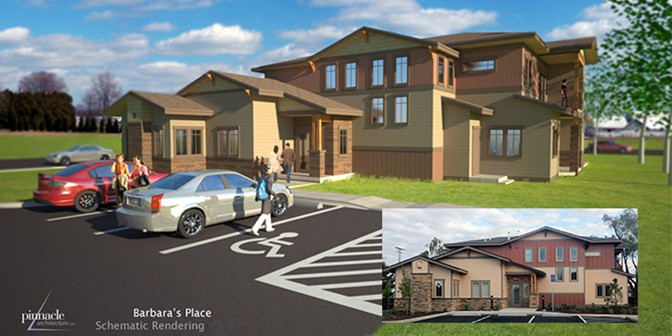(Photo above: Barbara’s Place | submitted by Pinnacle Architecture)
Central Oregon is a beautiful place to live – 300 days of sunshine, endless outdoor activities, and a great community. Unfortunately thousands of individuals in our community are in need. We know we have a shortage of housing options and a need for resources. We also have an amazing network of individuals and organizations that want to help. Taking an idea and turning it into to a reality – whether a homeless shelter or affordable housing complex – takes many steps. Understanding the process and benefit of a development feasibility study will increase fundraising success for many of these important projects.
Having a Well Designed Plan
You have an idea and the passion to drive it. You have identified a need, done your research, created a business plan, and are now evaluating the physical location. It’s important to document your potential building’s needs and requirements. For example, if planning a shelter: how many beds will you need? What type of kitchen is required to feed your desired number of users? The goal is to document your long-term and short term needs, wants, and requirements.
Choosing the Right Location
You have seen something for sale at a stellar price or been gifted a piece of property. Once a building or property is identified a development feasibility study is crucial. Your consultant will study the property, contact the city to learn about their requirements and zoning, dig into city records to uncover any potential issues (Was it a past industrial site with contaminated soil? Does it have conditional uses?), and begin to evaluate placement or redevelopment of the building including access, utilities, and parking requirements. You may need to assess 2 or 3 sites before finding the right one to fit your needs.
A site feasibility study typically takes 3-4 weeks and the final report includes:
• Jurisdiction information including code and zoning analysis – what does the city require (i.e. sidewalk improvements, new intersection, etc.) and will they support the type of project you are proposing?
• Site plan – where is the best placement of the building for efficiency, access, etc.?
• Floor plans – layouts that show how your requirements will most efficiently fit within the suggested building footprint.
• Cost estimate – both construction cost (cost to construct the building including architecture, consultants, and the builder’s time and materials) and project cost (includes construction plus all other potential fees – survey, permits, appraisal, etc.) This is important when beginning a capital campaign. It’s best to know the full scope of costs to ensure you’re raising an appropriate amount of money to complete the project.
• Marketing collateral – Capital fundraising campaigns are much more effective when you can actually see what a project will look like! Part of the marketing collateral will be a 3D rendering to visualize the project. Typically you’d include this in brochures to describe the project, boards for viewing at community events, and on your website to communicate your project.
Engaging the Community
Now that you have a viable location and visual of what it will look like you need to begin to build community consensus and win advocates. This is where having a well thought out plan with information from your feasibility study is going to benefit your cause. People are more likely to invest in your idea if it’s presented as a real project versus a “potential” idea. It’s important to have consistent and transparent communication with your potential site’s surrounding community early and often. You’ll need to show them the benefit of your project in their community. Here is an example:
Hermiston was planning a women’s shelter to support a growing need in their community. Early in the process a public meeting was planned to discuss the upcoming project. Concerns by the community arose that the shelter would draw unwanted spouses or individuals connected with the women in the shelter to the area. At the meeting a site plan showed how security worked at the facility and the city police guaranteed regular patrols and a 3-5 minute response time on any related calls. Communicating the benefit of this facility in their neighborhood – an increase in overall security– resulted in community consensus and a successful project.
Fundraising Success
With a good plan and input/consensus from the community you are ready for your fundraising campaign. This isn’t as easy task but you have resources whether it’s hiring a fundraising consultant or exploring the many funding opportunities (grants, loans, credits, etc.) yourself. When applying for government funds, like Oregon’s Housing Grant and Tax Credit Program, or private funds, like The Ford Family Foundation’s programs, having a well documented plan and development feasibility study will increase your probability of receiving funding.
www.pinnaclearchitecture.com
Barbara’s Place, developed by Housing Works, is a six-unit apartment community designed to provide supportive housing for persons with disabilities. It received grants from the Oregon Housing and Community Services and Oregon Department of Human Services Addictions and Mental Health.
A feasibility and master plan is assisting fundraising for Teen Challenge in Bend to create a new multi-purpose building to foster their residential and training program that helps teens who are overcoming addiction transition back to society.





